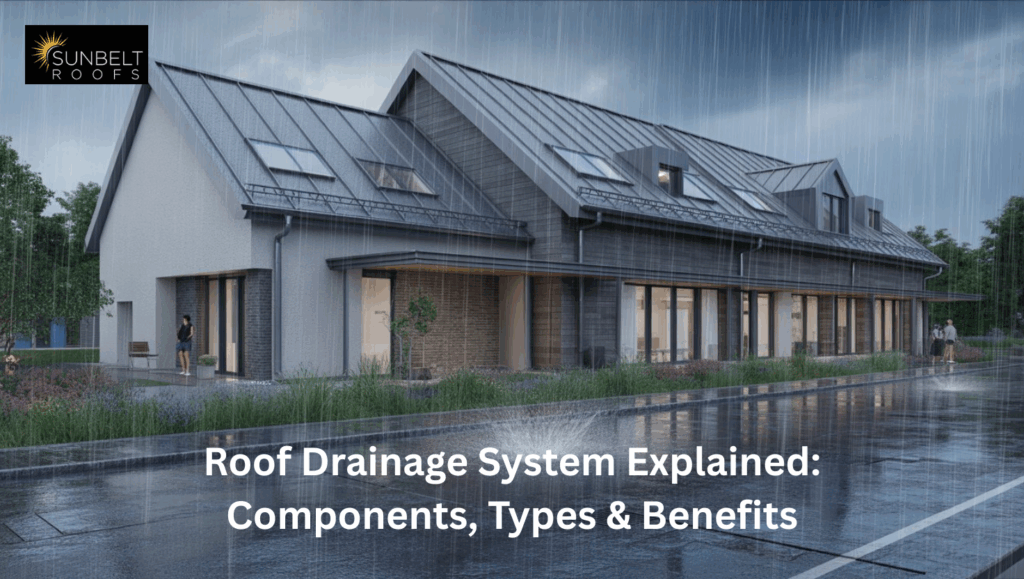
Your roof is more than a big, flat lid; it’s the front line against rain, snow, and wind. Yet a rooftop can only do its job if water is guided away from it. That’s the job of a roof drainage system. These roof drainage systems funnel rainwater and melting snow off your roof and away from your building, saving you from leaks, mold, and pricey repairs.
We’re diving into the parts, types, and perks of these roof drainage systems design tips. Whether you have a house or a big office, knowing the basics of roof drainage helps you keep your investment safe for many years.
What Are Roof Drainage Systems?
Simply put, a roof drainage system collects water and moves it away from your building. Left unchecked, rain can collect, find tiny cracks, and ice can expand. The roof may sag, the walls can crack, and the whole structure can be put in danger. Roof drainage systems stop those problems before they can start.
The design of these systems changes based on the type of roof, whether it is flat or sloped. Downspouts and gutters are common on sloped roofs, but flat roofs typically need drains, scuppers, or siphonic systems on the inside. No matter what form, material, or climate the roof is, a good roof drainage design makes sure that water flows well.
Key Components of Roof Drainage Systems
Roof Gutters
These are basically the frontline defense. Installed along the roof’s edge, gutters grab rain before it goes rogue. A correctly placed roof gutter drain keeps water from streaming down brick or siding and weakening the building’s footing. Choices in materials like aluminum for lightness and low cost, steel for strength, or copper for a stunning patina let you balance toughness and looks.
Downspouts and Leaders
Once the gutter collects water, the job falls to downspouts. They channel the flow straight down and away from the building. Planning where to place these tubes is key; the water should land well away from the foundation. Downspouts often use elbows to redirect the flow and splash blocks to spread it, keeping drips from wearing away the landscape next to the building.
Roof Drains
On commercial buildings with flat roofs, interior roof drains are frequently the go-to choice. Set into the lowest points of the roof, the drains sit behind grates that keep debris out. Beneath the roof, a network of pipes carries storm water safely away. An effective roof drainage detail plan calculates how much rainwater the system needs to handle, ensuring pipes are the right size to prevent any water from backing up and threatening the structure.
Scuppers
Scuppers are openings in the tops of parapet walls that let the rainwater escape. These elements are a backup safety net that are usually put in place at regular intervals and are commonly connected to vertical downspouts. If a main drain becomes blocked, the water can flow out through the scuppers, decreasing the risk of pooling that might otherwise harm the roof surface.
Sumps, Splash Blocks & Accessories
These small fixtures can make a big difference. A sump or a splash block near the downspout softens the force of water hitting the ground and keeps it from washing away soil near the foundation. When teamed up with roof drainage systems and scuppers, these components boost the entire system’s effectiveness, protecting both the building and the landscape.
Types of Roof Drainage Systems
Traditional Gutter Systems
The most common way to drain water from a house is using built-in roof gutters. They are cheap, easy to put up, and work well on most sloped roofs. With the right roof gutter drain in the right spot, the system sends precipitation to the ground without spilling, which helps keep siding, wall finish, and landscaping dry and safe.
Inner Roof Drains
Inner roof drains are built right into commercial and industrial flat roofs. Water enters through drain strainers, then moves down vertical pipes hidden inside the roof. This kind of roof drainage design maintains the membrane free of ridge guards, which makes the system small, effective, and not too busy to look at.
Scupper Systems
Scuppers add extra protection where roof designs include parapet walls. Water drains through these openings to the outside, stopping ponds from forming. Besides the functional benefit, scuppers create lines that can lift a roof’s skyline, balancing form with water control.
Siphonic Drainage Systems
Siphonic systems are a breakthrough for large commercial buildings. Instead of relying on gravity, these drains create a pressure difference that rushes water to vertical pipes. Smaller pipes save on material and labor costs, sawed even drill-free layouts are reduced, and peak data on roof water is turned into design.
Benefits of Efficient Roof Drainage Systems
A carefully engineered roof drainage system design delivers value well beyond redirecting water.
Prevents Structural Damage: Guiding water off keeps walls, ceilings, and foundations dry, avoiding future repair shock.
- Extends Roof Lifespan: Standing water speeds up the roof’s disintegration, which makes it last longer. An excellent roof drainage detail will make the roof last longer.
- Improves Safety: Hidden, irrelevant, no puddles to refreeze, and no ice dams to languish inside either.
- Enhances Curb Appeal: A roof that drains right usually clears a well.
- Supports Property Value: An attractive, well-functioning roof can lift a home’s market appeal at first glance.
Roof Drainage Detail: Key Design Considerations
Great roof drainage system design doesn’t just happen; it’s carefully planned. Here are the key points to nail in the design phase:
Roof Slope & Load Capacity
If your roof drainage design is flat, expect to invest in extra drainage planning versus a pitched roof. Base calculations assure that the roof can temporarily hold all the rainfall until the system kicks in and the water leaves.
Local Climate
Heavy rains or snow? You’ll need bigger drains and extra downspouts. Areas exposed to hurricane winds, like Louisiana and Mississippi, call for extra reinforcement against flying debris and high water.
Building Codes & Regulations
Following state and local drainage codes is non-negotiable. It keeps your project safe and your budget free from fines down the road. Skilled contractors can stamp and lay out systems that meet both levels of the law.
Maintenance Access
Every roof drainage system should be easy to clean and check. Access points in the design help save things from getting stuck and costing a lot of money.
Choosing the Right Roof Drainage System
There’s no one-size-fits-all;’s a balancing act of:
- Type of Building: Gutters are often helpful for residential dwellings, but siphonic drains may be needed for big commercial buildings.
- Budget: Standard gutters are cheaper upfront, but siphonic setups can lower life-cycle costs on big boxes and factories.
- Aesthetic Appeal: Modern buildings might want systems that are hidden or mix seamlessly with the architecture.
- Professional Advice: Working with a reliable roofing contractor in Louisiana and Mississippi makes sure that the roof is put on correctly and will last for a long time.
Advanced Drainage and Fortified Roofing
As climate catastrophes get harder to foresee, established mechanisms may not be enough on their own. Homeowners and companies in Mississippi are increasingly combining drainage planning with fortified roofing services Mississippi to make sure their roofs are as strong as possible. When combined with sophisticated roof drainage systems, fortified roofing offers better protection against heavy rain, storms driven by wind, and water damage that lasts for a long time.
For businesses, combining drainage systems with commercial roof installation makes sure that big buildings are up to code, work well, and last a long time.
Maintenance Tips for Roof Drainage Systems
Great roof drainage systems can’t sit and hope. Give them the basics, and they pay you back:
- Check those gutters and downspouts for clogs. Do it at the start and end of each season.
- Sweep out debris right after storms and strong winds.
- Look at slope and alignment; keep them as the plans showed.
- Seal any leaks right away, or your roof might start leaking.
- Book a pro check at least once a year for the complete review.
Conclusion
To protect your house or company, you need roof drainage systems that are well-designed and well-maintained. There are many types of systems, such as gutters, downspouts, siphonic, and scupper designs, that all work together to move water away from your property. You may safeguard your roof and make your whole building last longer by focusing on roof drainage system design and including the proper roof drainage detail.
If you’re a homeowner in need of a dependable roof gutter drain or a business owner developing a cutting-edge roof drainage design, Sunbelt Roofs has the know-how to protect your investment for many more seasons to come.
